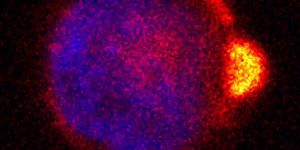New Experimental Model for ALS and MS Immunotherapies
A new mouse model allows researchers to study the impact of immune cell function in the brain on diseases like amyotrophic lateral sclerosis (ALS) and multiple sclerosis (MS). With the hope of developing new immunotherapies for these diseases, researchers from the Karolinska Institutet use the model in a new study.
Immune cells called monocytes travel through to blood into the brain and damage neurons and the myelin sheath, a protective layer of tissue that promotes the transmission of nerve impulses. In ALS, neurons controlling voluntary muscle movement are affected. These are the neurons responsible for chewing, walking, and talking. Over time, these neurons deteriorate completely. Most people with ALS die from respiratory failure three to five years after they first develop symptoms.
With MS, an autoimmune disease and the most common neurological disease affecting young adults, the immune system mistakenly attacks the myelin sheath, affecting neurons in the brain and spinal cord. People with MS experience numbness, weakness, and pain in the arms and legs, vision loss, tremors, fatigue, dizziness, bowel and bladder dysfunction. Over 400,000 people in the United States and 2.5 million people across the globe are affected by MS.
Macrophages are phagocytic cells, which means they serve the immune system by engulfing and digesting bacteria and other unfriendly objects they come across. Macrophages in the brain, called microglia, specialize in function as directed by the cytokine TGF-β. Can TGF-β prevent monocytes from becoming harmful, instead alter them to function positively like the microglia?
"We already knew that TGF-β is produced in the brain and is important for giving microglia their specialised functions," explained first author Harald Lund. "So we figured that monocytes should also respond to TGF-β when they enter the brain. We were curious to see what would happen if the monocytes lost the ability to respond to TGF-β."
Using the new model, researchers removed the mice’s microglia. This resulted in monocytes rushing into the brain and spinal cord, mimicking the activity of microglia and causing no pathological symptoms. But when researchers inhibited TGF-β activity, the monocytes started to destroy the myelin in the spinal cord, and a lethal neurodegenerative disease developed. The symptoms of that disease looked just like ALS.
In the future, researchers could use a similar model to test more aspects of diseases like ALS and MS, as well as test new potential immunotherapies.
"There are many deadly neurodegenerative diseases in humans, but a lack of experimental models for developing new immunotherapies," explained Bob Harris, PhD. "This new disease model will be a valuable addition to our research programme and we hope that the next study will result in a new, effective therapy."
The present study was published in the journal Nature Immunology.
Sources: Karolinska Institutet, Discovery MS, Mayo Clinic, National Institute of Neurological Disorders and Stroke









